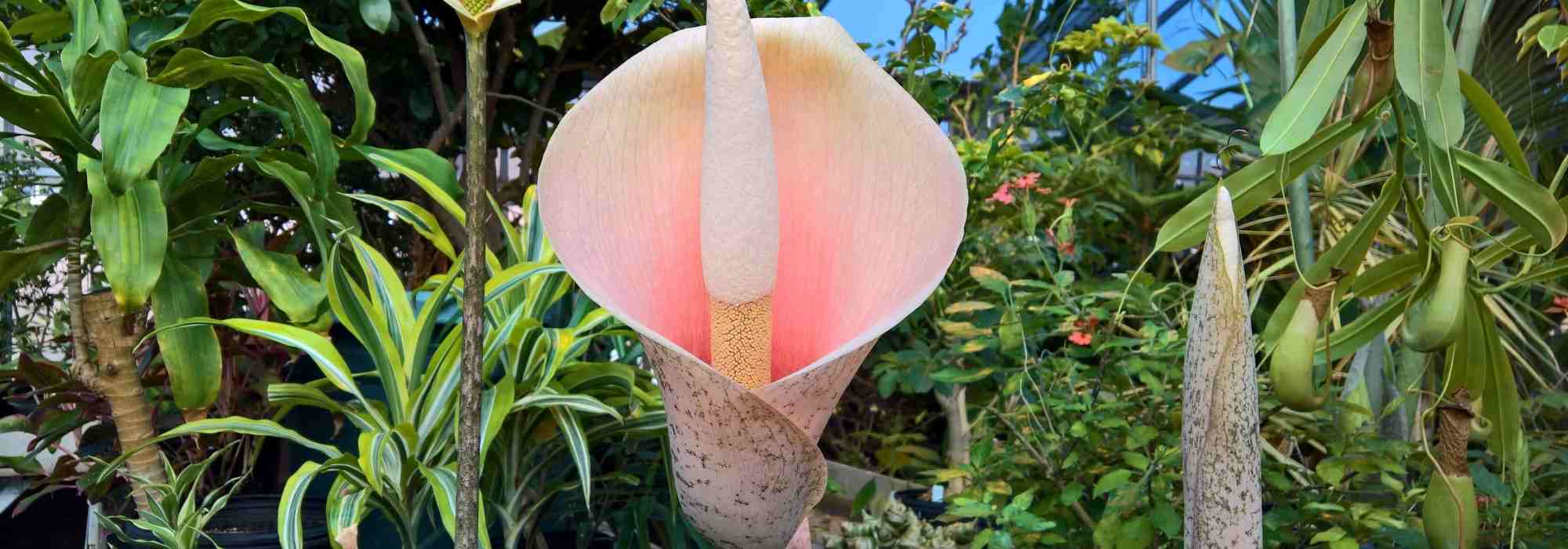
Amorphophallus : planting and caring
Contents
The Amorphophallus in a nutshell
- This is a strange and fascinating bulbous perennial plant
- It has a very large bulb
- Flowering occurs in late spring, with spectacular large spathes
- It can grow up to 1.50 m in height, or even more
- Being frost-sensitive, it must be protected in winter and is best grown in large pots
The word from our expert
The Amorphophallus is a perennial tuberous plant, a cousin of the arum. Like the Amorphophallus bulbifer and Amorphophallus konjac, it displays a spectacular cornucopia-shaped flowering in late spring, with a large white, violet, purple, pink, or yellow-green spathe surrounding a long spadix. The flowering occurs only on mature specimens before the foliage appears. It sometimes emits a foul odour, as in the case of the Amorphophallus titanum (the Titan Arum), intended to attract pollinators. In the early years, it produces a single leaf that can grow up to 1.50 m tall, or even more.
Cultivating Amorphophallus is quite delicate. It grows from a very large, somewhat tender underground bulb, which can eventually measure 30 cm in length and weigh 1 to 2 kg, sometimes much more. Hardy down to -8/-10°C, this curious bulb is easier to grow in a large pot to be stored away in winter during its dormancy period. However, it can be planted in the ground in milder regions, provided it is well protected from rain in winter.
Discover how to cultivate this true botanical curiosity!
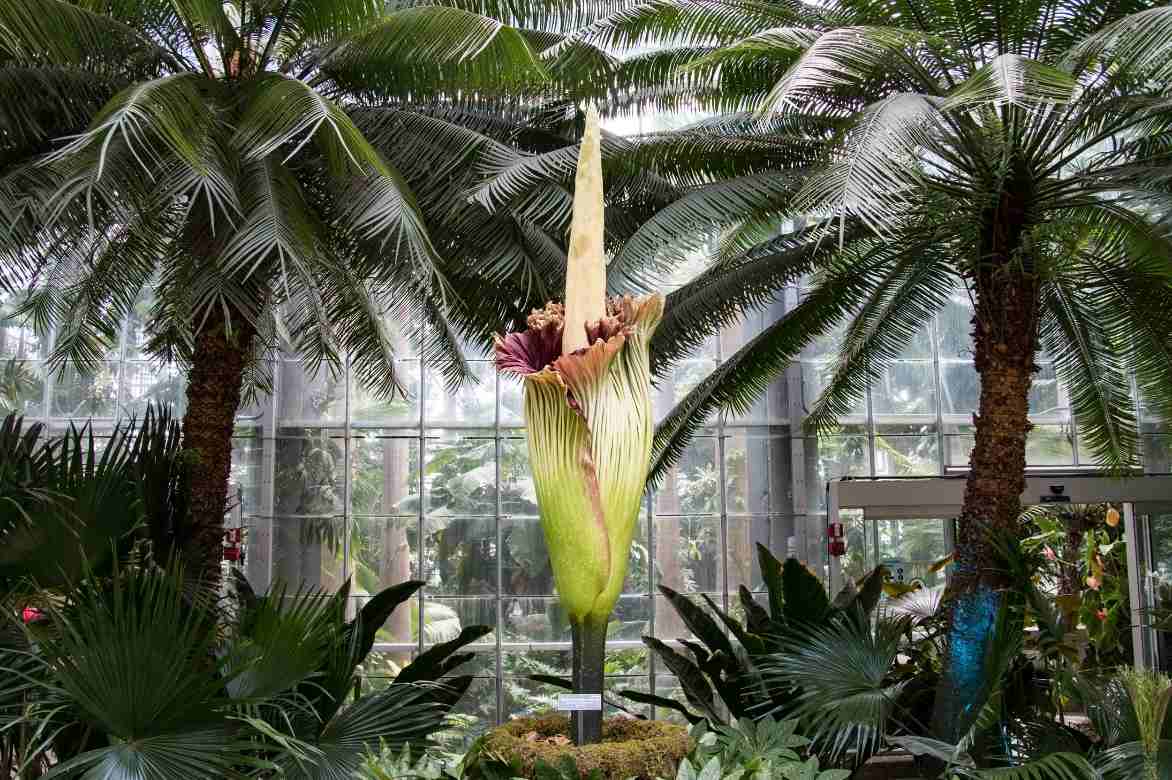
Amorphophallus titanum
Description and Botany
Botanical data
- Latin name Amorphophallus
- Family Araceae
- Common name Amorphophallus
- Flowering May to June
- Height 1 to 2 m
- Exposure Partial shade
- Soil type Rich, moist, well-drained
- Hardiness -10°C
The Amorphophallus is a perennial plant with a tuber, belonging to the Araceae family, like the Arum or Calla or florist’s arum (Zantedeschia). The genus Amorphophallus includes 170 species native to tropical and subtropical regions of Asia, among others, and around 400 hybrids. They are found naturally in open forests, on limestone hills, or at high altitudes. Some species are endemic to Nepal and Bangladesh, where they grow in the Himalayan mountains.
Amorphophallus is often grown in pots in our climates because it fears winter moisture and is not very hardy, requiring protection from the cold in winter.
This herbaceous perennial plant develops from a large tuberised root. The tuber takes various shapes depending on the species—globular, flattened, elongated, or irregular. It can measure up to 80 centimetres and weigh between 1 and 15 kg, sometimes much more depending on the species. The Amorphophallus titanum, or titan arum, is exceptionally large, with a root that can eventually exceed 80 cm in diameter. The Amorphophallus konjac also boasts extraordinary dimensions.
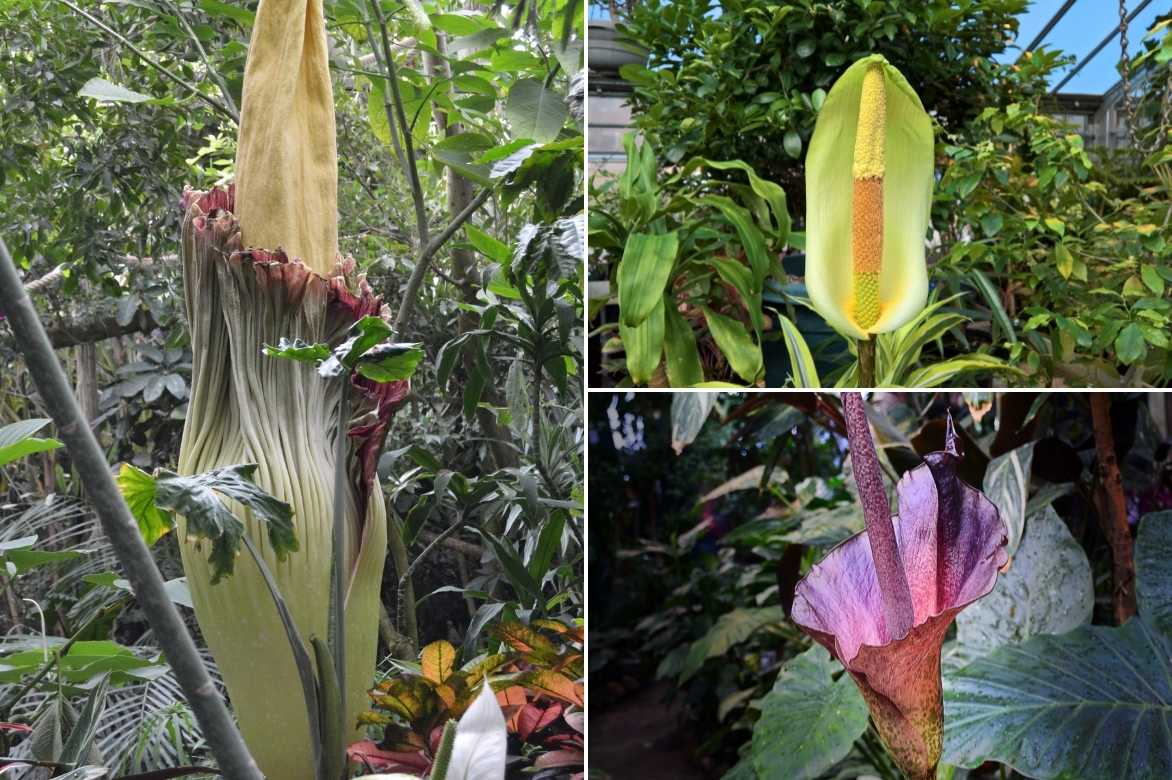
Amorphophallus titanum (left), Amorphophallus napalensis, and Amorphophallus konjac in bloom
During its first years after planting, the plant initially produces leaves, which are deciduous and disappear in winter. The foliage emerges from the soil in spring, usually in May-June, in the form of a sturdy green petiole. At its tip, the leaf blade unfolds into a large, solitary green leaf divided into numerous leaflets with prominent veins. This leaf can reach heights of 1.80 to 2.20 m and lasts for about 4 months. In their natural habitat, the leaf blade can span up to 4 m in width in the largest species. The Amorphophallus bulbifer is unique in producing bulblets in the axils of the leaflets and along the petiole’s branches—a true botanical curiosity.
The spectacular flowering is rare and not to everyone’s olfactory taste! It only occurs on mature plants, after several years. Some species take longer to flower and reflower. Flowering happens after 2 to 4 years and then annually in some, like the Amorphophallus bulbifer. It is not always annual and may appear randomly over the years.
From late spring to late summer, the bulb emits an inflorescence above the ground, at the base of the plant, before the foliage. It is typical of the Araceae family, consisting, like arums, of a bract shaped like a funnel, called a spathe, which envelops a spadix—a fleshy spike of flowers. This central, erect, and fleshy column resembles a phallus, hence the plant’s vernacular name, meaning “misshapen penis” in Greek. It can reach impressive proportions in some Amorphophallus species, nearing 70 cm in length. The spathe measures about 20 to 30 cm in height. Once again, the Amorphophallus titanum stands out with its flower, reaching nearly 2.50 m in height—one of the largest in the vegetable kingdom!
The spathe colours range from brown-purple, soft pink, violet-purple, greenish-white, to pale yellow-green. The long spadix is white, yellow with a brown-pink base, or dark violet, depending on the species, creating a striking contrast with the surrounding spathe.
Some Araceae ready for fertilisation emit a putrid, nauseating odour designed to attract pollinating insects, such as flies and bees—an extraordinary stratagem! The inside of the chamber is lined with ridges to temporarily trap them. The insects remain imprisoned in the spathe long enough to pollinate the female flowers, then are released the next day, covered in pollen, to fertilise another spathe.
These spathe flowers are followed by globular berries—red, orange, white, yellow, or blue, depending on the species—clustered tightly together.
The plant disappears during extreme heat. It enters dormancy in late summer, spending the winter underground at rest, before reappearing in spring after restoring its nutrient reserves.
The tuber of the Amorphophallus campanulatus is edible and commonly used in Asian cuisine.
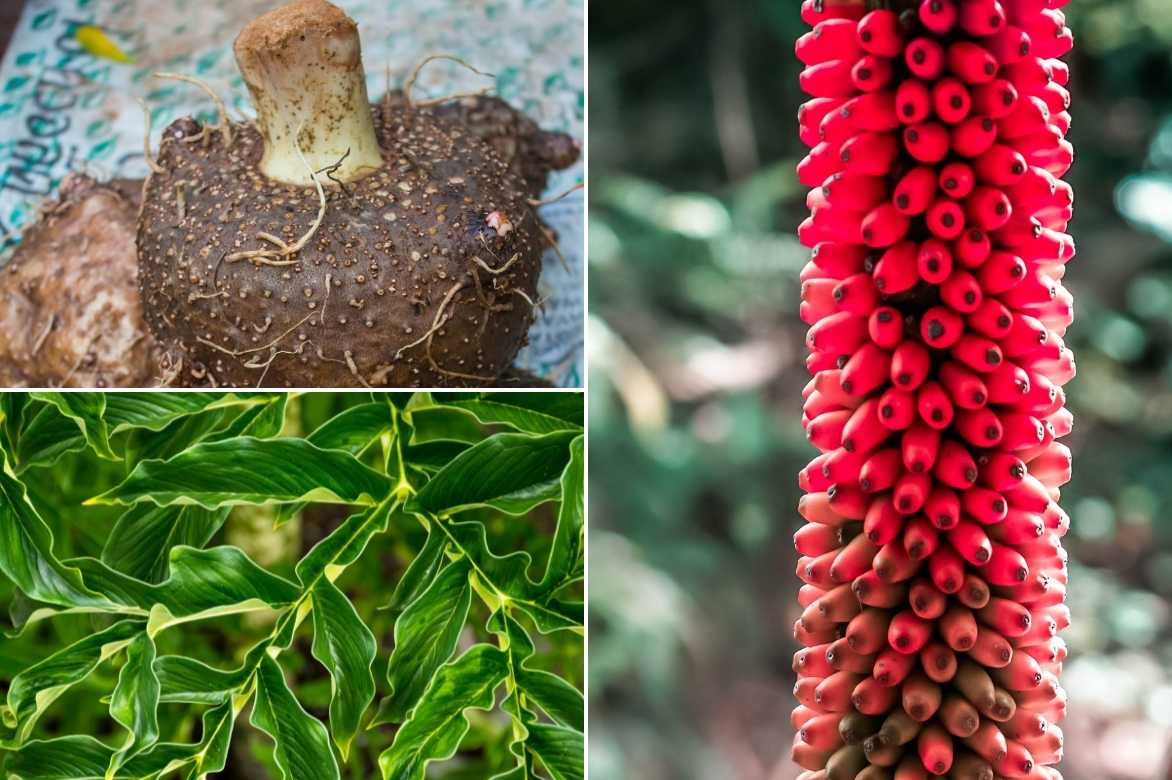
Tuber, foliage, and fruit of the Amorphophallus konjac
Main species and varieties
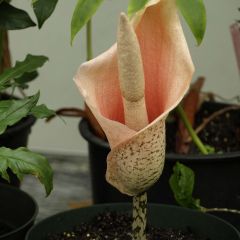
Amorphophallus bulbifer - Voodoo Lily
- Flowering time June, July
- Height at maturity 1,20 m
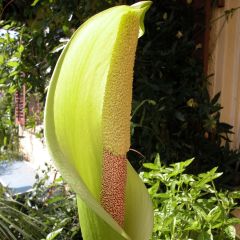
Amorphophallus napalensis - Voodoo Lily
- Flowering time May, June
- Height at maturity 1 m
Discover other Amorphophallus
View all →Available in 2 sizes
Available in 1 sizes
Available in 1 sizes
Planting Amorphophallus bulbs
Where to Plant It?
Suited to a tropical climate, hardy down to -10°C in very well-drained soil, this exceptional plant can only be grown in the ground in our milder and less rainy regions. In summer, the Amorphophallus requires a minimum daytime temperature of 22°C. It is essential to grow it in pots, which you can shelter indoors during winter in colder and wetter regions. Overwintering the bulbs or pots in a cool, well-ventilated space is crucial.
Reserve a spot in light sun or partial shade for the Amorphophallus bulbs; they need brightness to flower but cannot tolerate scorching exposure. As in nature, the Amorphophallus thrives in forests and damp undergrowth, so plant it in well-drained, light soil, rich in organic matter with a slightly acidic tendency, typical of woodland soil, which remains cool from May to September. Stagnant moisture could lead to tuber rot. Maintain soil coolness with a good mulch during the growing season.
It also needs space, as its leaf can reach up to 2 metres in height.
When to Plant Amorphophallus?
The Amorphophallus bulbs should be planted in the ground in spring, from March to May, when there is no longer any risk of frost.
How to Plant It?
In the Ground
Prepare the soil well by digging it over. If your soil is too heavy, add compost and gravel if water tends to stagnate. Ensure the bulb is buried deep enough so it remains stable and can support the large leaf to come.
- Dig a hole three times the volume of the bulb
- Place the bulb at the bottom, 30-50 cm deep, or under 2 to 2.5 times its diameter
- Fill with a mixture of heather soil and compost
- Water
- Mulch the soil once the plant is established
In a Pot
Amorphophallus bulbs are well-suited to pot cultivation, especially as they are quite sensitive to cold. Choose a container large enough, at least twice as wide and deep as the tubercle, to allow for good root development. The substrate should be light and rich. A mix of 50% good compost, 25% perlite or pumice, and 25% heather soil will work well.
- Spread a layer of clay pebbles at the bottom of the pot for drainage
- Partially fill with the mix to a depth of 5-10 cm
- Place the bulb so it is buried under 2 to 2.5 times its diameter
- Fill with the enriched soil mix, adding a slow-release fertiliser
- Water and keep moist
- Move the pot outside after the frosts and place it in partial shade
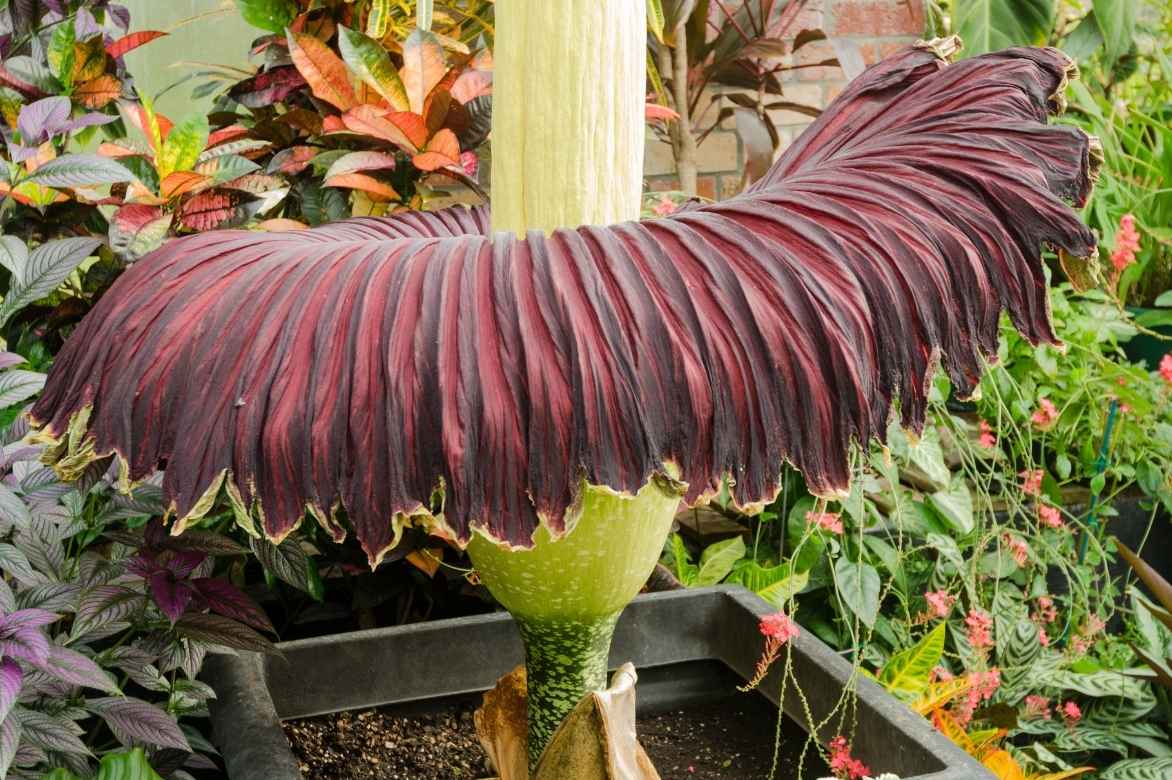
Amorphophallus titan grown in a pot
Cultivation and Care
In the ground
The Amorphophallus is easy to grow provided you follow a few simple steps. In colder regions where temperatures regularly drop below -10°C, lifting the bulbs from the ground is necessary to protect them from the cold. Proceed as you would with dahlia bulbs, storing them in a cellar or garage, dry and sheltered from the cold, as soon as the first frosts arrive and the foliage has fallen.
In regions with mild winters where frosts are light and infrequent, the tubers can remain in place: simply protect them in winter with a thick mulch of dry leaves or straw.
During the growing season, keep the soil moist by watering regularly but not excessively: constantly waterlogged soil may cause the bulb to rot. We also recommend mulching the soil with an organic mulch to prevent it from drying out too quickly. During the growth period, you can add a layer of compost or well-rotted manure around the base of the stump.
Stop watering when the plant enters dormancy and loses its foliage. Keep it dry while the bulb regenerates.
Remove the leaves once they have turned yellow.
In pots
Watering will need to be slightly more frequent if grown in pots. Ensure the soil remains moist but not waterlogged, never allowing the substrate to dry out completely. It’s all about balance!
Once a month, from May to August, feed with a seaweed-based fertiliser.
Potted specimens should be brought indoors at the first sign of frost, stored in a garage or unheated room, and returned outside in spring. To respect the plant’s dormancy, avoid watering in winter.
Diseases and potential pests
The Amorphophallus bulbs are susceptible to nematodes and scale insects, which attack the tubercles, especially indoors. Nematodes are small parasitic worms that leave warts on the bulbs and cause them to dry out. To repel them, you can plant Tagetes nearby. In a greenhouse or indoors, if you notice the presence of scale insects, visible by the white waxy powder they leave on the roots, repot the plant in fresh, healthy compost.
Multiplication
The aerial bulblets of Amorphophallus bulbifer can be harvested and then replanted to produce new young plants. Propagation is also achieved by dividing the tubercles in spring.
By Division
- Dig up the rootstocks with a garden fork if they are in the ground, otherwise take advantage of repotting
- Cut them into several pieces using a disinfected knife or by hand
- Replant them immediately in their final location, in the garden or in pots
Combining the Amorphophallus
This woodland plant will thrive in the garden alongside other plants that, like it, enjoy cool to moist soils, such as Hostas or ferns (Dicksonia antarctica), the Lysichiton americanus with its large butter-yellow spathes, or the Chinese loosestrife.
In a cool, shaded border, the Amorphophallus can also be paired with fatsias, banana trees with their broad foliage, or non-running bamboos like Fargesia. Consider also pairing it with lush clumps of Hakonechloa for an exotic feel, or with Gunnera tinctoria for a truly luxuriant scene.
It will thrive in a heather soil border alongside an Hydrangea heteromalla, which, like it, enjoys light shade or partial shade.

In the centre, Amorphophallus titanium, paired with Hydrangea heteromalla, Fatsia japonica, Gunnera tinctoria, Hostas ‘Francee’, and Musa sikkimensis
Useful resources
- Discover our spectacular spring bulbs!
Frequently asked questions
-
Is it normal for my Amorphophallus not to flower every year?
The leafing, flowering, and dormancy periods of the *Amorphophallus* are difficult to pinpoint. Flowering occurs on plants that are several years old. Some will flower after just 2 years of cultivation, others after 3 to 4 years, and sometimes you may have to wait even longer for them to flower for the first time. Flowering is not necessarily annual; it may take 4 to 6 years for them to flower again.
- Subscribe!
- Contents
![[plant id="amorphophallus" info="all"] [plant ficha_plant="Amorphophallus"]](https://en.promessedefleurs.eu/blogwp/wp-content/uploads/2022/05/Amorphophallus-tout-savoir-.jpg)































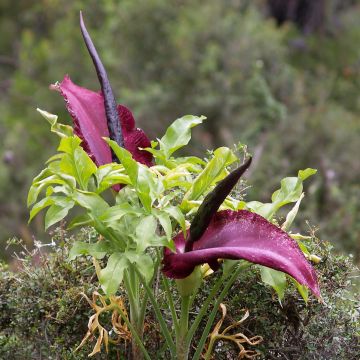


Comments